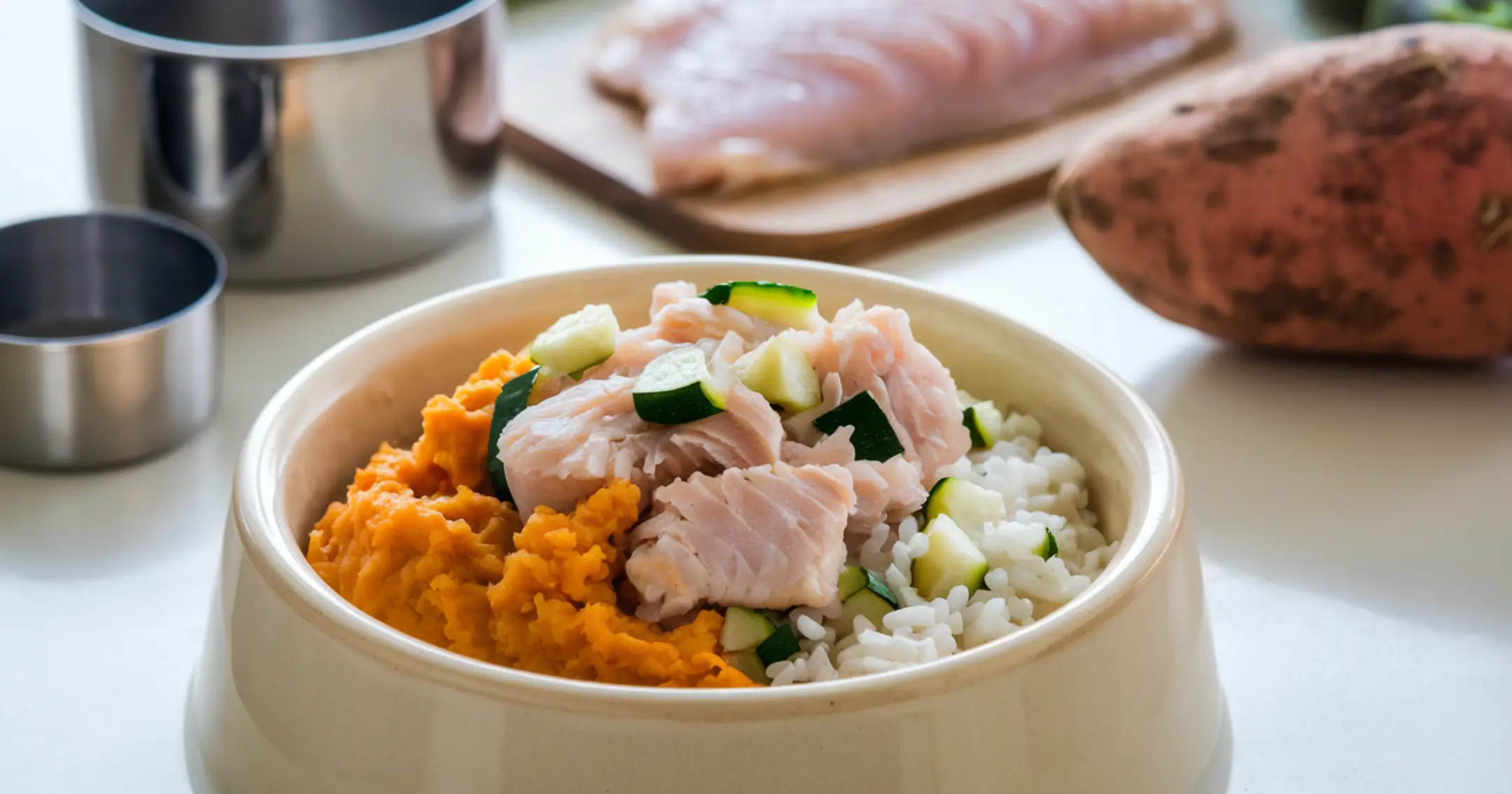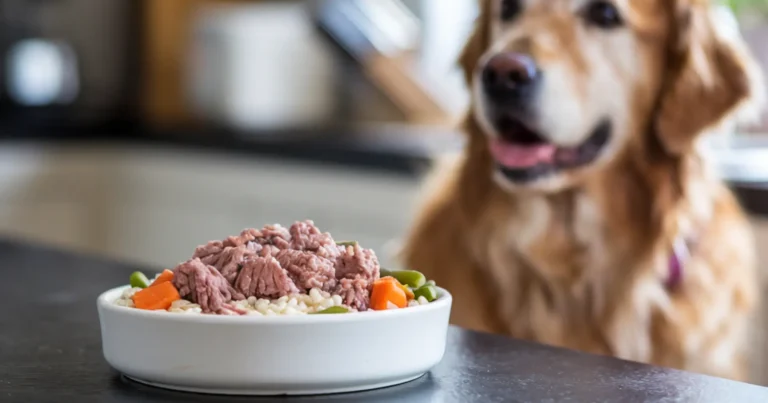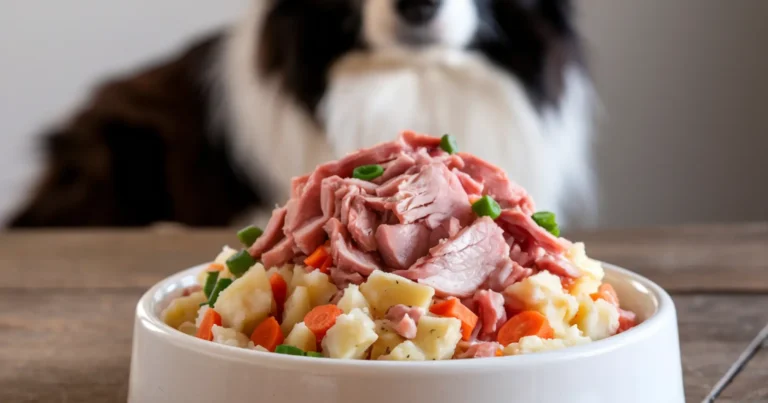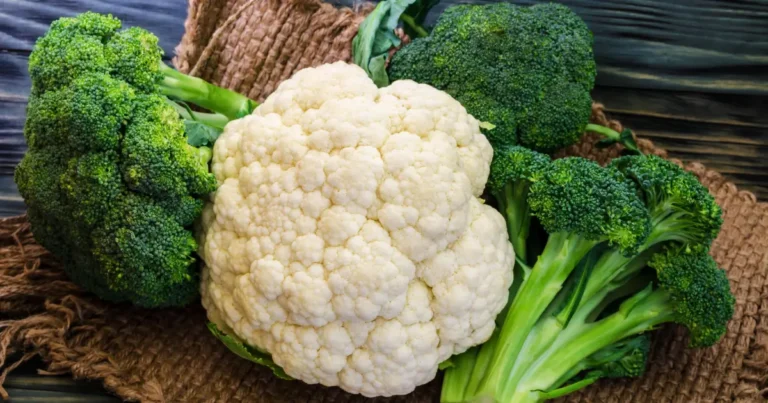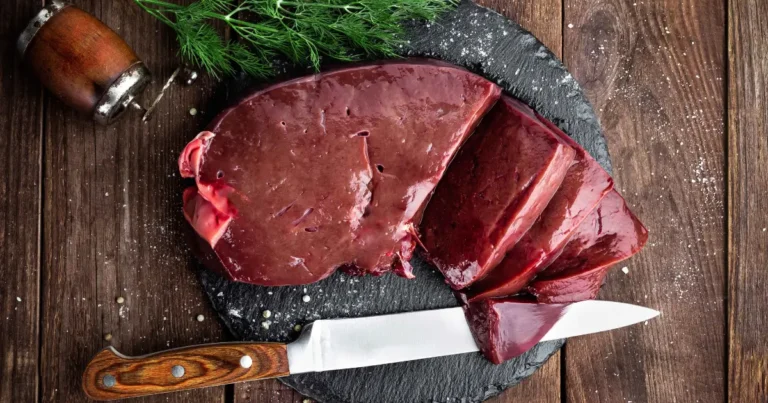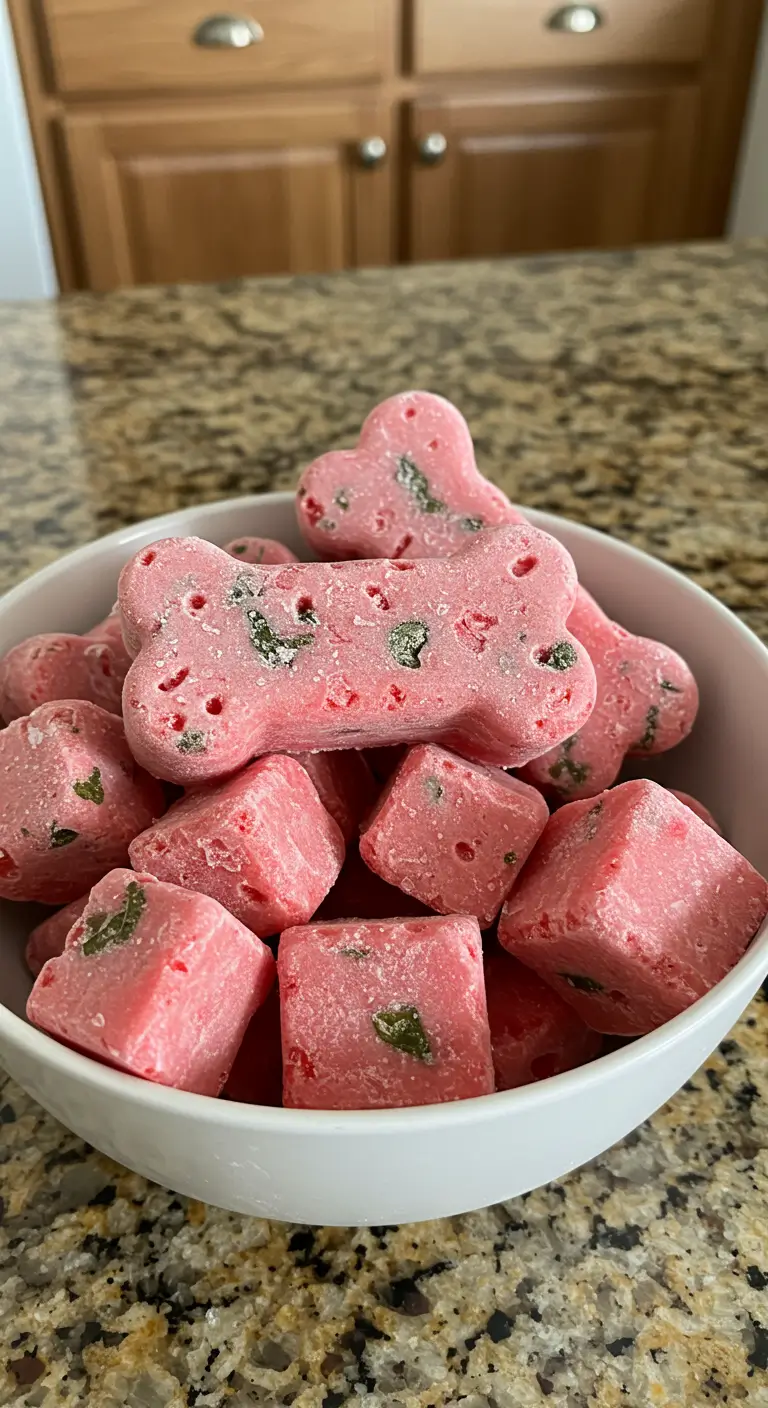White Fish with Sweet Potato Dog Food: 6 Healing Steps
When caring for a dog with pancreatitis or digestive sensitivity, finding the gentlest yet nutritionally complete recipe becomes essential. This white fish with sweet potato dog food offers one of the most digestible and anti-inflammatory options available for dogs with sensitive systems. The combination of lean protein from white fish and complex carbohydrates from sweet potatoes creates an exceptionally gentle meal that supports healing while minimizing strain on the pancreas.
This comprehensive guide provides a veterinarian-approved recipe specifically designed as part of a low-fat dog diet for recovery and maintenance. We’ll explore the unique benefits of these ingredients, walk you through six detailed preparation steps, and provide crucial serving guidelines to support your dog’s recovery from pancreatitis or digestive issues.
Table of Contents
Why White Fish and Sweet Potato Are Ideal for Sensitive Dogs
Before preparing this therapeutic recipe, it’s important to understand why these particular ingredients work so well for dogs with digestive challenges or pancreatitis in dogs.
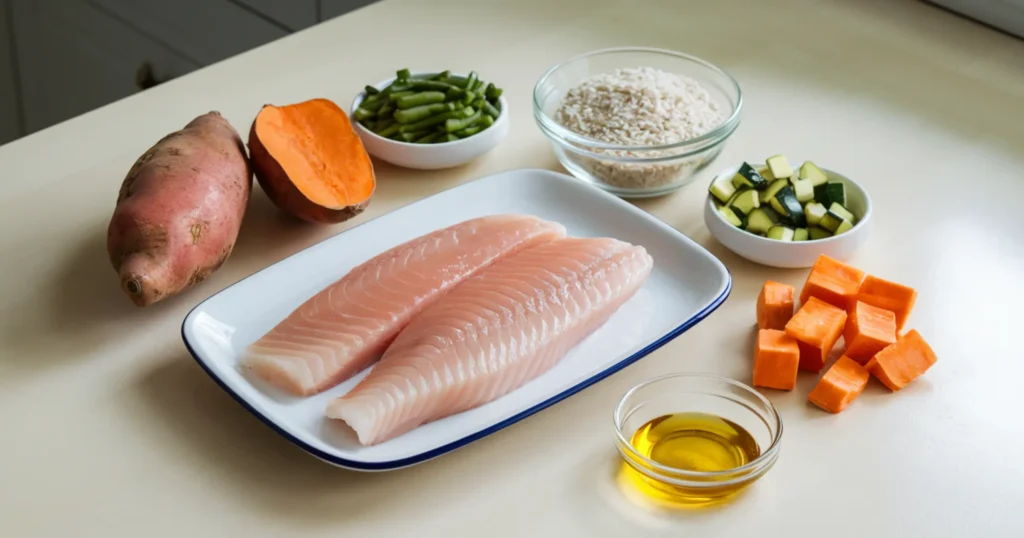
The Gentle Power of White Fish for Canine Health
White fish for dogs offers several exceptional benefits that make it ideal for sensitive digestion:
- Extremely low fat content: Many white fish varieties contain less than 2% fat, making them perfect for dogs with pancreatitis
- Highly digestible protein: The protein structure in white fish is easily broken down and absorbed with minimal digestive effort
- Natural source of omega-3s: Provides anti-inflammatory fatty acids that may help reduce pancreatic inflammation
- Novel protein source: Excellent alternative for dogs who may have developed sensitivities to more common proteins like chicken
- Minimal allergenic potential: Less likely to trigger food sensitivities or allergic reactions
- Complete amino acid profile: Provides all essential amino acids needed for tissue repair and maintenance
White fish varieties like cod, haddock, and tilapia are particularly well-suited for this therapeutic recipe.
Sweet Potato Benefits for Digestive Health
Sweet potatoes complement white fish perfectly in this low-fat dog diet by providing:
- Complex carbohydrates: Slow-releasing energy that helps maintain stable blood sugar levels
- High soluble fiber: Supports healthy digestion and helps regulate bowel movements
- Rich in beta-carotene: Provides antioxidants that support healing and reduce inflammation
- Naturally sweet flavor: Appeals to most dogs, encouraging eating when appetite may be reduced
- Excellent vitamin content: Particularly high in vitamins A, C, and B6
- Minimal fat content: Contains very little fat while providing satisfying bulk and nutrients
This powerful combination creates a foundation for a highly digestible, low-fat meal that provides essential nutrition while being exceptionally gentle on the digestive system.
White Fish with Sweet Potato Recipe for Dogs with Digestive Issues
This white fish with sweet potato dog food has been formulated according to veterinary nutritional guidelines for dogs with sensitive digestion or pancreatic concerns.
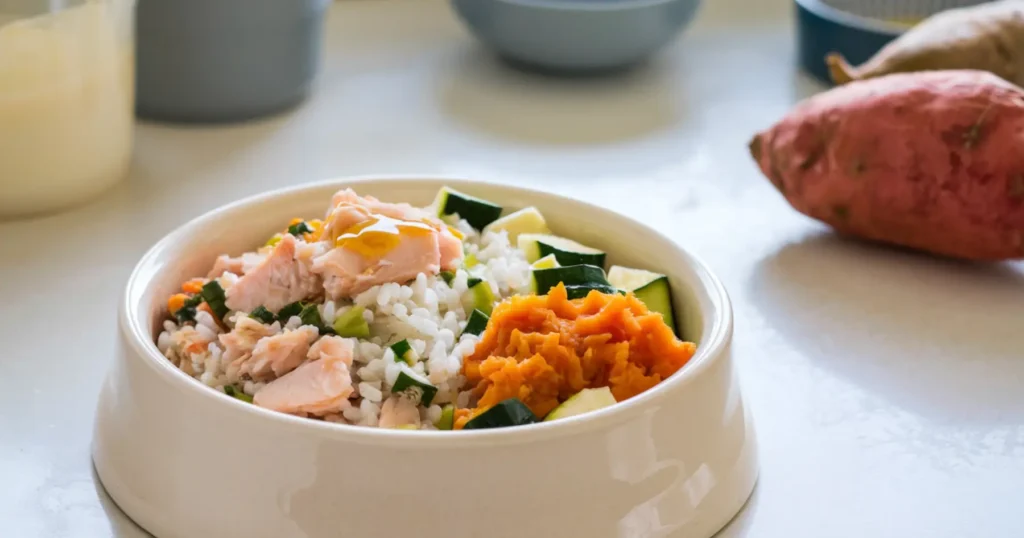
Recipe Quick Facts
- Prep Time: 15 minutes
- Cook Time: 25 minutes
- Total Time: 40 minutes
- Yield: Approximately 6 cups of food
- Serving Size: Varies by dog’s weight (see serving guidelines below)
- Storage: Refrigerate up to 3 days or freeze up to 2 months
- Diet Type: Very low-fat, easily digestible
- Main Ingredients: White fish fillets and sweet potatoes
Ingredients
- 1 pound (454g) white fish fillets (cod, haddock, or tilapia)
- 2 cups (400g) sweet potatoes, peeled and cubed
- ½ cup (100g) white rice, uncooked
- 4 cups (950ml) water
- ½ cup (65g) green beans, finely chopped
- ¼ cup (30g) zucchini, finely chopped
- 1 tablespoon (15ml) fish oil (salmon or cod liver oil)
- ¼ teaspoon calcium carbonate supplement
Equipment Needed
- Large pot with lid
- Steamer basket or colander that fits in a pot
- Measuring cups and spoons
- Food scale (for precise measurements)
- Fork or potato masher
- Storage containers with tight-fitting lids
- Cutting board and knife
Special Instructions for Maximum Digestibility
When preparing this white fish with sweet potato dog food for a dog with pancreatitis or severe digestive issues, consider these important modifications:
- For acute pancreatitis: Puree the finished recipe to create an extremely easy-to-digest texture
- For dogs with very sensitive systems: Remove all fish skin and ensure absolutely no bones remain
- For dogs in early recovery: Increase the water content slightly to create a more hydrating meal
- For ongoing management: Follow the recipe exactly as written to provide optimal nutrition and fiber content
- For long-term use: Consult with a veterinary nutritionist about additional supplements needed for complete nutrition
6 Healing Steps to Prepare White Fish and Sweet Potato Dog Food
Follow these detailed steps to create this gentle, therapeutic meal for your dog with digestive issues or pancreatitis.
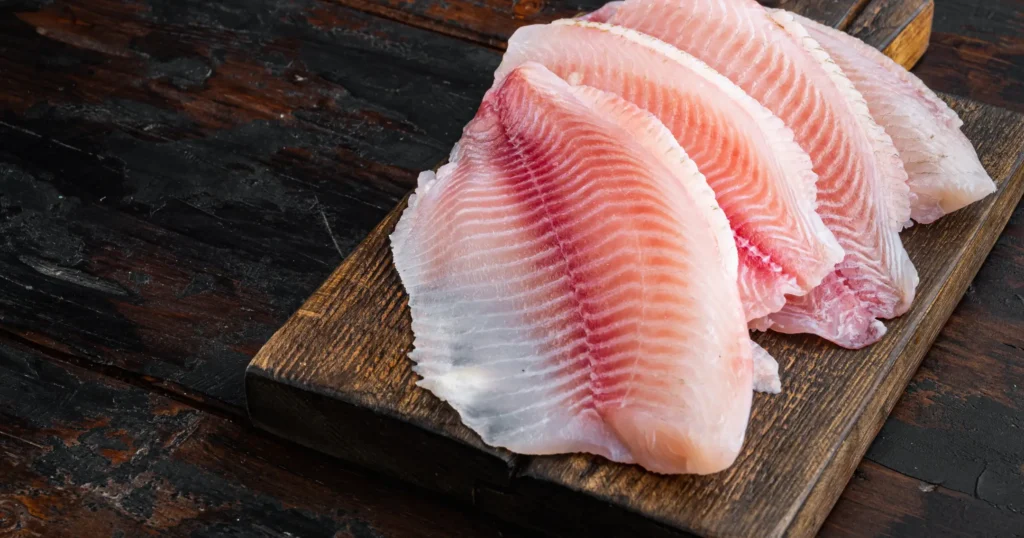
Step 1: Prepare the White Fish
- Check the fish fillets carefully for any bones, removing them completely with tweezers if found
- Rinse the fillets under cold water
- Cut the fish into small, bite-sized pieces appropriate for your dog’s size
- Set aside on a clean plate while you prepare other ingredients
Fish selection tip: Choose fresh fish when possible, but frozen fillets that have been properly thawed work well too. Wild-caught fish typically offers more omega-3 rich foods for dogs than farm-raised varieties, but either option works for this recipe.
Step 2: Cook the Rice
- Use cold water to rinse the white rice until the water runs clear.
- Bring two cups of water to a boil in a large pot.
- Add the rice, stir once, then reduce the heat to low
- For 15 to 18 minutes, cover and simmer the rice until it is soft and the water has been absorbed.
- Take off the heat and leave it covered for five minutes.
- Fluff with a fork and spread on the bottom of a large mixing bowl to cool slightly
Rice cooking tip: White rice is preferable to brown rice for this low-fat dog diet as it’s more digestible for dogs with sensitive stomachs or those recovering from pancreatitis in dogs.
Step 3: Prepare and Cook the Sweet Potatoes
- Cut the sweet potatoes into 1-inch cubes after peeling them.
- Put in a pot with one inch of water to cover it.
- Bring to a boil, then reduce heat to medium
- Simmer for 15 minutes until very soft (a fork should easily pierce them)
- Drain thoroughly and allow to cool slightly
- Mash the sweet potatoes with a fork or potato masher until smooth
Sweet potato tip: The orange-fleshed varieties are highest in beta-carotene, making them ideal for this healing recipe.
Step 4: Steam the Vegetables
- While the sweet potatoes are cooking, prepare the green beans and zucchini
- Chop both vegetables into very small pieces (the smaller, the more digestible)
- Put veggies in a steamer basket over water that is boiling.
- Steam for 5-7 minutes until very soft
- Take off the heat and let it cool a little.
Vegetable tip: For dogs with extreme sensitivity, you may puree these vegetables completely to maximize digestibility in this white fish with sweet potato dog food.
Step 5: Cook the Fish
- Using the same pot from the vegetables (now empty), add 2 cups of water and bring to a gentle simmer
- Carefully add the fish pieces
- Poach for 5-7 minutes until fish is fully cooked and flakes easily with a fork
- Using a slotted spoon, carefully remove the fish pieces, leaving behind any cooking liquid
- Break the fish into smaller flakes with a fork, checking again for any bones
Cooking method tip: Poaching is the ideal method for preparing white fish for dogs as it uses no added fat and keeps the fish moist and flavorful.
Step 6: Combine All Ingredients
- In a large mixing bowl, combine the cooked rice and mashed sweet potatoes
- Gently fold in the flaked fish
- Add the steamed vegetables
- Sprinkle the calcium carbonate supplement evenly over the mixture
- Drizzle the fish oil across the top
- Be careful not to mash the fish too much as you gently mix all the ingredients until they are well combined.
- Before serving or storing, let the mixture cool fully.
Combining tip: Adding the fish oil at the end preserves its omega-3 rich foods for dogs benefits, which can be diminished by high cooking temperatures.
Serving Guidelines for White Fish and Sweet Potato Dog Food

Your dog’s weight, level of activity, and particular medical requirements will determine the right serving size. Always consult your veterinarian for personalized feeding recommendations, especially for dogs with pancreatitis.
General Portion Guidelines by Weight
- Small dogs (under 20 lbs): ¼ to ½ cup per meal
- Medium-sized dogs (20–50 lbs): ½ to 1 cup per meal
- Large dogs (50-90 lbs): 1 to 1½ cups per meal
- Giant breeds (over 90 lbs): 1½ to 2 cups per meal
Feeding Schedule Recommendations
For dogs with pancreatitis or sensitive digestion:
- Phase of acute recovery: four to six tiny meals spread out throughout the day
- Maintenance phase: 2-3 meals daily, evenly spaced
Monitoring tip: Weigh your dog weekly to ensure they’re maintaining appropriate weight. Adjust portions if you notice unintended weight loss or gain.
Storage and Preparation Tips
- Refrigeration: Store portions in airtight containers for up to 3 days
- Freezing: Freeze individual meal-sized portions for up to 2 months
- Thawing: Thaw frozen portions in the refrigerator overnight
- Warming: Serve at room temperature or slightly warmed (never hot)
- Freshness: Discard any uneaten food after 20 minutes
Transitioning to the White Fish and Sweet Potato Diet
When introducing this white fish with sweet potato dog food to dogs with sensitive digestion, a careful transition is essential to prevent digestive upset.
If Transitioning from Another Homemade Diet
- Day 1-2: 75% current diet, 25% white fish and sweet potato mixture
- Day 3-4: 50% current diet, 50% white fish and sweet potato mixture
- Day 5-6: 25% current diet, 75% white fish and sweet potato mixture
- Day 7: 100% white fish and sweet potato mixture
If Transitioning from Commercial Food
- Day 1-3: 75% commercial food, 25% white fish and sweet potato mixture
- Day 4-6: 50% commercial food, 50% white fish and sweet potato mixture
- Day 7-9: 25% commercial food, 75% white fish and sweet potato mixture
- Day 10: 100% white fish and sweet potato mixture
For very sensitive dogs: Extend this transition period over 2-3 weeks instead of 7-10 days. Watch for any signs of digestive upset and slow down the transition if needed.
Why This Recipe Excels for Pancreatitis Recovery
This white fish with sweet potato dog food is specifically designed to support pancreatic health through several key mechanisms:
Exceptionally Low Fat Content
With a fat content of approximately 10% of calories (even lower than chicken-based recipes), this recipe is well below the threshold that typically triggers pancreatic inflammation. White fish is naturally one of the leanest protein sources available, making it ideal for a low-fat dog diet.
Anti-Inflammatory Properties
The omega-3 fatty acids in white fish and the added fish oil provide anti-inflammatory benefits that may help reduce pancreatic inflammation. These beneficial fats do not trigger the pancreas in the same way that saturated animal fats do, making them safe even for dogs with pancreatitis in dogs.
Maximum Digestibility
The combination of easily digestible protein from white fish and soluble fiber from sweet potatoes creates a meal that requires minimal digestive effort. This reduces strain on the entire digestive system, including the pancreas, allowing for healing and recovery.
Nutrient Density
Despite being restricted in fat, this recipe provides excellent nutrition with:
- High-quality protein for tissue repair
- Complex carbohydrates for sustained energy
- Fiber for digestive regulation
- Natural vitamins and minerals
- Essential fatty acids for overall health
Monitoring Your Dog’s Response

When feeding this white fish with sweet potato dog food, watch for these positive signs:
Signs of Improvement
- Increased energy: More alert and interested in normal activities
- Improved appetite: Eating consistently and with enthusiasm
- Better digestion: Normal bowel movements without diarrhea or constipation
- Reduced symptoms: Less vomiting, abdominal pain, or discomfort
- Coat improvement: Over time, the omega-3 rich foods for dogs in this recipe may improve coat quality
Warning Signs
These symptoms require veterinary attention:
- Vomiting after eating
- Continued or worsening diarrhea
- Signs of abdominal pain
- Lethargy or depression
- Loss of appetite for more than 24 hours
Recipe Variations and Alternatives
While this basic white fish with sweet potato dog food works well for most dogs with pancreatitis, these veterinarian-approved variations may help address specific needs:
For Dogs Who Don’t Like Fish
- Consider our Chicken and Rice Recipe for Dogs with Pancreatitis as an alternative protein source
- Our Turkey and Pumpkin Dog Food Recipe also offers an excellent low-fat option
For Dogs Needing Even More Digestible Options
- Substitute white rice with well-cooked quinoa for additional protein
- Consider cottage cheese as an alternative protein in our Cottage Cheese & Rice Recipe
For Dogs Who Need Variety in Their Diet
- Rotate between our various low-fat recipes to provide nutritional diversity
- Try our upcoming Simple Vegetarian Recipe for occasional meat-free options
Always introduce variations gradually and with veterinary approval, keeping the overall fat content extremely low as required for pancreatitis management.
Long-Term Dietary Considerations

While this white fish with sweet potato dog food provides excellent nutrition during recovery and management of pancreatitis, long-term considerations include:
Potential Supplementation
For extended use (over 2 weeks), your veterinarian may recommend:
- Complete multivitamin specifically for dogs
- Additional calcium supplementation
- Digestive enzymes if pancreatic enzyme production is compromised
- Probiotics for overall gut health
Balance with Commercial Options
Some veterinarians recommend:
- Rotating between homemade recipes to ensure nutritional variety
- Combining homemade food with prescription low-fat commercial diets
- Using commercial supplements designed to balance homemade diets
Key Takeaways for White Fish and Sweet Potato Dog Food
- Ultra-low-fat protein: White fish provides high-quality protein with minimal fat, ideal for pancreatitis in dogs.
- Gentle digestion: This combination is one of the most easily digestible recipe options for sensitive dogs.
- Anti-inflammatory benefits: The omega-3 rich foods for dogs in this recipe may help reduce inflammation.
- Careful preparation matters: Following the 6-step process ensures proper therapeutic value.
- Veterinary oversight is essential: This recipe works best as part of a vet-supervised treatment plan.
- Monitoring is critical: Watch for positive signs and any adverse reactions.
- Gradual transitions: Always introduce new foods slowly to sensitive dogs.
- Long-term planning: Consider nutritional completeness for extended feeding.
Conclusion: A Superior Option for Sensitive Digestive Systems
This white fish with sweet potato dog food recipe offers one of the gentlest, most digestible options for dogs recovering from or managing pancreatitis and other digestive conditions. The extremely low-fat protein from white fish combined with the soothing, nutritious carbohydrates from sweet potatoes creates a meal that supports healing while placing minimal strain on the digestive system.
The six detailed preparation steps ensure this recipe maintains its therapeutic value while being accessible for any pet parent to prepare at home. By following these guidelines and working closely with your veterinarian, you can provide your dog with a nutritious, healing meal that supports their recovery and long-term health.
For more comprehensive information about managing canine pancreatitis through diet, visit our main guide on Homemade Dog Food for Pancreatitis, which provides broader information about this condition and nutritional approaches to support healing.
Frequently Asked Questions
Which white fish varieties are best for dogs with pancreatitis?
Cod, haddock, and tilapia are excellent choices for this white fish with sweet potato dog food recipe. These varieties are particularly low in fat while providing high-quality protein. Avoid fattier fish like salmon or trout when cooking for dogs with pancreatitis. Always choose fillets rather than whole fish to minimize fat content.
Can I use frozen fish for this recipe?
Yes, frozen fish fillets work well for this recipe. Ensure they are completely thawed before cooking, and drain any excess liquid. Frozen fish is often more economical and convenient, while still providing the benefits of white fish for dogs with sensitive digestion.
Is this diet complete and balanced for long-term feeding?
This recipe is designed primarily for short to medium-term use during the recovery and management of pancreatitis. For long-term exclusive feeding (beyond 2-3 weeks), additional supplementation would be necessary to ensure complete nutrition. Consult a veterinary nutritionist for guidance on making this low-fat dog diet complete for long-term use.
How does fish oil benefit dogs with pancreatitis?
The omega-3 fatty acids in fish oil have anti-inflammatory properties that may help reduce pancreatic inflammation. These beneficial fats are processed differently by the body compared to saturated animal fats, making them safe in small amounts even for dogs with pancreatitis. The inclusion of fish oil makes this recipe beneficial as omega-3 rich foods for dogs while maintaining its low-fat profile.
Can puppies eat this white fish and sweet potato recipe?
This recipe is mostly intended for older dogs with digestive issues or pancreatitis. Different nutrients are needed by puppies for growth and development. If your puppy has been diagnosed with pancreatitis, work with a veterinary nutritionist to modify this recipe appropriately to meet growth requirements while managing the condition.
How can I tell if my dog is tolerating this recipe well?
Positive signs include normal, formed bowel movements, good energy levels, no vomiting, and willingness to eat. Dogs who are tolerating this diet well should not show signs of abdominal discomfort like hunching, whining when touched, or reluctance to move. Get in touch with your veterinarian if your dog exhibits any alarming signs.
Can I add herbs or seasonings to improve flavor?
For dogs with pancreatitis in dogs or sensitive digestion, it’s best to avoid any seasonings or herbs. Dogs appreciate the natural flavors of the ingredients, and adding seasonings could introduce unnecessary irritants. If your dog seems reluctant to eat, try warming the food slightly to enhance the natural aroma rather than adding seasonings.
How do omega-3 fatty acids in this recipe differ from other fats?
Omega-3 fatty acids, like those found in white fish for dogs and the added fish oil, have different chemical structures than the saturated fats found in meat and dairy. These differences mean they are processed differently by the body and don’t stimulate the pancreas in the same way. This makes them safer for dogs with pancreatitis when used in carefully controlled amounts, as in this recipe.
References and Resources
For more information on managing canine digestive issues and pancreatitis, consult these valuable resources:
- Tufts University Cummings School of Veterinary Medicine: Fish in the Diet
- American Kennel Club: Can Dogs Eat Fish?
Your Dog Tried It? Drop a Review Below!
There are no reviews yet. Be the first one to write one.

